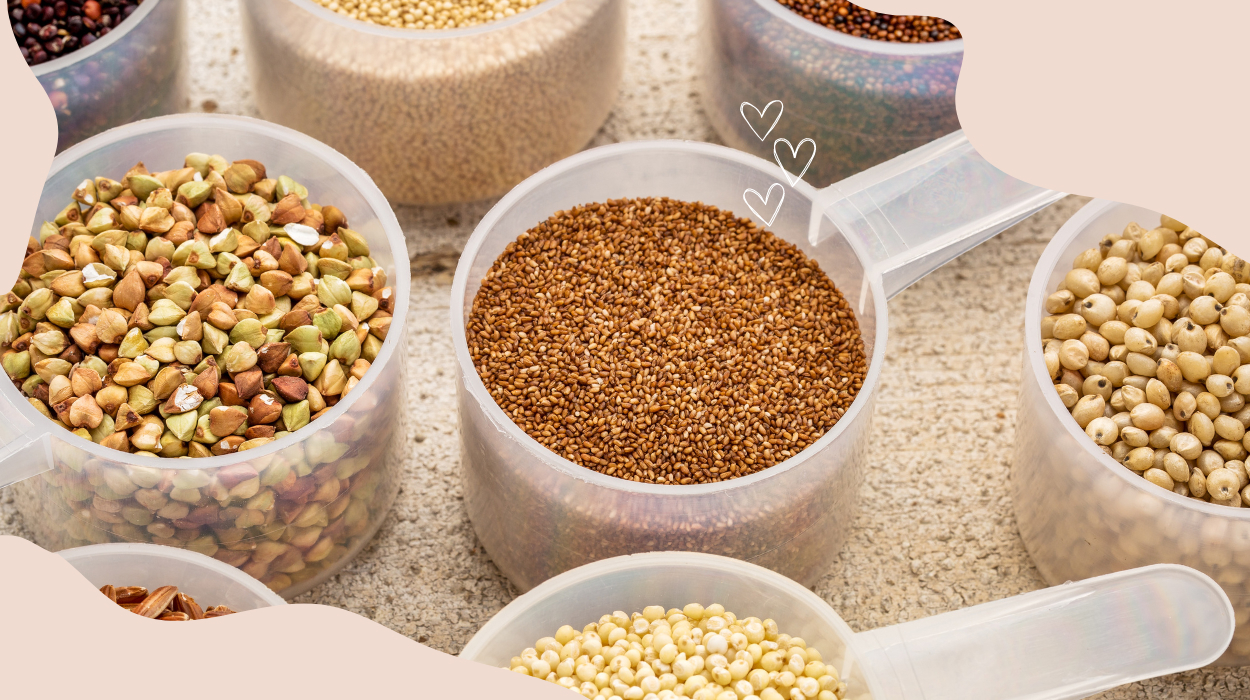 Expert's opinion
Expert's opinion
Expert's opinion
The article is a subjective view on this topic written by writers specializing in medical writing.
It may reflect on a personal journey surrounding struggles with an illness or medical condition, involve product comparisons, diet considerations, or other health-related opinions.
Although the view is entirely that of the writer, it is based on academic experiences and scientific research they have conducted; it is fact-checked by a team of degreed medical experts, and validated by sources attached to the article.
The numbers in parenthesis (1,2,3) will take you to clickable links to related scientific papers.
Gluten-Free Grains: 10 Options To Try In 2024

There are many naturally gluten-free grains. The only gluten-containing grains are wheat, rye, and barley.[1] Unfortunately, these three grains are quite popular, but they can typically be substituted for a gluten-free alternative.
Whether you are looking for high-protein grains or low-carb grains for your gluten-free diet, plenty of naturally gluten-free options are available. Keep reading to answer the frequently asked question. What are gluten-free grains?
Super Healthy Gluten-Free Grains
Here is a list of 10 super healthy gluten-free grains to incorporate in your diet:
- Rice.
- Corn.
- Oats.
- Quinoa.
- Millet.
- Buckwheat.
- Amaranth.
- Sorghum.
- Teff.
- Cañihua.
Gluten-Free Grains You Should Add To Your Diet
Rice
Rice comes in many forms, all of which are gluten-free. Even the confusingly named glutinous rice[2] is gluten-free. Glutinous rice gets its name from its sticky texture, not because it contains gluten.
White and brown long-grain rice are the most popular types of rice in the United States. Brown and wild rice varieties are gluten-free whole grains,[3] whereas white rice is a refined grain because it is processed to remove the hull. White, brown, and wild rice are similar in caloric value but have different macro and micronutrients.
For example, white and brown medium-grain types of rice have moderate amounts of protein – seven[4] and eight[5] grams per 100 grams, respectively, whereas the same amount of wild rice has nearly 15 grams of protein.[6]
White rice also has significantly less fiber than brown and wild rice. White rice contains 1.4 grams of fiber per 100 grams dry, whereas brown rice contains 3.4 grams and wild rice contains 6.2.
Corn
Corn is another delicious, versatile, and naturally gluten-free grain. Corn can be harvested when soft and enjoyed right off the cob, frozen, or canned. However, if you eat corn that has been harvested while soft, it is considered a starchy vegetable, not a grain.[7] Corn is only considered a grain when it matures and dries before being harvested.
For example, the dried, whole kernels that are used to make popcorn are considered a grain. In fact, popcorn is a healthy, whole-grain, gluten-free snack that is fairly high in fiber.[8] Dried corn is also used to make many popular products such as cereal, chips, cornmeal, cornstarch, corn syrup, and so much more!
Corn is also a popular base for tortillas; however, be aware that some tortillas are made with a mix of flour and corn tortillas. Always ask about the ingredients and the preparation environment of your corn tortillas!
Oats
You have probably seen many different types of oats at your local grocery store, including quick cook, rolled oats, instant oats, and steel-cut oats. All these types of oats are naturally gluten-free; however, the risk for cross-contamination is high, so you should always look for a gluten-free label.
Oats are another great source of fiber[9] and whole grains.
Quinoa
Quinoa is a small round grain that is typically white or red. It is a whole grain high in all the essential amino acids and fiber. Quinoa contains 14 grams of protein and seven grams of fiber[10] per 100 grams dry. Quinoa also has a significant amount of antioxidant vitamin E.[1]
Millet
Millet is another small, round, gluten-free grain. Cooked millet can be used in the same way that rice and quinoa are used. Millet can also be ground into flour to replace wheat flour. You can also add millet into baked goods like scones or muffins as you would with a seed or nut.
Millet is a whole grain and fairly high in protein and fiber. Millet contains 11 grams of protein and nine grams of fiber[11] per 100 grams dry. Millet is also a good source of amino acids and the B vitamins[12] thiamine, niacin, and riboflavin.
Buckwheat
Buckwheat is a gluten-free pseudocereal that is high in protein, fiber, and several minerals. Buckwheat contains 13 grams of protein and 10 grams of fiber[13] per 100 grams dry. Buckwheat is also a good source of vital amino acids.[14]
Amaranth
Amaranth is a gluten-free pseudocereal that looks like quinoa and has many of the same nutritional benefits. Amaranth is a whole grain and is high in protein and fiber. Amaranth contains 14 grams of protein and seven grams of fiber[15] per 100 grams dry. Amaranth also has a significant amount of the antioxidant vitamin E.[1]
Sorghum
Sorghum is another gluten-free pseudocereal that looks and behaves very similarly to quinoa. Sorghum is a whole grain rich in protein and fiber. Sorghum contains 11 grams of protein and seven grams of fiber[16] per 100 grams dry.
Similarly to millet, sorghum is also a good source of amino acids and the B vitamins[1] thiamine, niacin, and riboflavin.
Teff
Teff is a gluten-free grain that is lesser known in the United States, but common in Ethiopian cuisine. Like many other grains on this list, teff is a good source of protein and fiber. Teff contains 13 grams of protein and eight grams of fiber[17] per 100 grams dry. Teff is also a good source of amino acids,[18] thiamine, calcium, and iron.
You can use teff in its seed form or as whole grain flour. You can use the seed form to make a porridge. The flour is extremely versatile and suitable to make bread, pizza crusts, and more!
Cañihua
Cañihua, sometimes also referred to as kaniwa, is one of several gluten-free ancient grains[19] from the Andean region. It is gaining popularity but can still be quite difficult to find. It is similar to quinoa in many ways. Cañihua is rich in the antioxidant vitamin E,[1] high in protein, and extremely high in fiber. It contains 14 grams of both protein and fiber[20] per 100 grams dry.
What Are Grains And Gluten-Free Grains?
Grains are typically split into two categories: cereals and pseudocereals.[21] Cereals come from grasses, and pseudocereals do not. All three gluten-containing grains, wheat, rye, and barley, are cereals.
Gluten-free grains include rice, corn, oats, quinoa, millet, buckwheat, amaranth, sorghum, teff, and cañihua. Of these grains, corn, rice, sorghum, millet, and teff are all cereals. Amaranth, buckwheat, and quinoa are all pseudocereals.
The United States Department of Agriculture suggests that half of your daily grains are whole grains.[22] Whole grains have the bran, germ, and endosperm intact.
Possible Benefits Of Eating Gluten-Free Grains
Eating gluten-free grains has some obvious health benefits for people following a gluten-free diet. Sticking to certified gluten-free grains is vital for people with celiac disease, gluten ataxia, and gluten neuropathy.[23] A gluten-free diet may also be helpful for people with non-celiac gluten sensitivity.
This is because maintaining a gluten-free diet is the only treatment for their disease. These patients will experience an overall improved quality of life[23] if they stick to eating gluten-free grains due to relief from symptoms like stomach pain, diarrhea, digestive system damage, and malabsorption.
Corn and rice are the two most popular gluten-free grains.[1] Researchers have recently become concerned that overreliance on these two grains may lead to a lack of certain vitamins and other nutrients. Thus, people on a gluten-free diet are now recommended to diversify their diet with other gluten-free grain options.
Many of these gluten-free grains are high in protein and vitamins; however, you may still need to supplement with other protein and vitamin sources, such as a gluten-free protein powder. Anytime you use supplements like protein powder, fat burners, or meal replacement bars, talk to a registered dietitian to ensure you meet your nutritional needs.
How To Add Gluten-Free Grains To Your Diet
Adding more gluten-free foods to your diet is easy! Many of these gluten-free grains can be used in the same way that you use rice. They can also be made into flour to replace wheat flour. For example, gluten-free pasta is often made with alternative grain flours like rice flour and can easily be incorporated just as you would regular pasta.
You can incorporate oats into your diet by eating oatmeal or granola. You can also buy or make your own oat flour. Oat flour can be made by grinding up rolled oats in your blender or food processor. Oat flour is a great replacement for whole wheat flour.
Quinoa and amaranth can be steamed and used in the same way you would use steamed rice. Both have a slightly more nutty flavor than rice. Quinoa, amaranth, and sorghum can also be puffed then used in a snack mix or as a salad topper. Unlike many other grains on this list, sorghum has a slight natural sweetness, and the stalk can be used to make syrup.
Buckwheat can be consumed in many forms, including whole groats, noodles, and flour. Soba noodles are a popular type of buckwheat noodle originating from Japan. Buckwheat flour can be used in many baked goods. Whole buckwheat groats can be steamed and then used in the same way you would use rice.
The Bottom Line
There are many gluten-free grains to choose from. If you eat gluten-free, you only need to avoid wheat, rye, and barely. Some good options for gluten-free grains include corn, rice, oats, quinoa, sorghum, amaranth, buckwheat, millet, teff, and cañihua. Next time you see these grains at the grocery store or in a meal kit, you will know they are gluten-free!
Frequently Asked Questions
People may want gluten-free grain options to accommodate their or their relatives’ gluten-free lifestyles.
Some grains that are good for people with gluten sensitivity are rice, corn, oats, quinoa, millet, buckwheat, amaranth, and sorghum.
Gluten-free people should avoid wheat, rye, and barely. These three grains contain gluten.
There are many gluten-free grains made from gluten-free grains that you can use to replace gluten-containing grains.
+ 23 sources
Health Canal avoids using tertiary references. We have strict sourcing guidelines and rely on peer-reviewed studies, academic researches from medical associations and institutions. To ensure the accuracy of articles in Health Canal, you can read more about the editorial process here
- Niro, S., D’Agostino, A., Fratianni, A., Cinquanta, L. and Panfili, G. (2019). Gluten-Free Alternative Grains: Nutritional Evaluation and Bioactive Compounds. [online] 8(6), pp.208–208. doi:https://doi.org/10.3390/foods8060208.
- Gui, Y., Chen, G., Tian, W., Yang, S.-H., Chen, J., Wang, F. and Li, Y. (2022). Normal rice flours perform better in gluten‐free bread than glutinous rice flours. [online] 87(2), pp.554–566. doi:https://doi.org/10.1111/1750-3841.16018.
- Aune, D., Keum, N., Giovannucci, E., Lars Thore Fadnes, Paolo Boffetta, Greenwood, D.C., Tonstad, S., Vatten, L.J., Elio Riboli and Norat, T. (2016). Whole grain consumption and risk of cardiovascular disease, cancer, and all cause and cause specific mortality: systematic review and dose-response meta-analysis of prospective studies. [online] pp.i2716–i2716. doi:https://doi.org/10.1136/bmj.i2716.
- Usda.gov. (2023). FoodData Central. [online] Available at: https://fdc.nal.usda.gov/fdc-app.html#/food-details/168879/nutrients.
- Usda.gov. (2023). FoodData Central. [online] Available at: https://fdc.nal.usda.gov/fdc-app.html#/food-details/169706/nutrients.
- Usda.gov. (2023). FoodData Central. [online] Available at: https://fdc.nal.usda.gov/fdc-app.html#/food-details/169726/nutrients.
- Usda.gov. (2023). AskUSDA. [online] Available at: https://ask.usda.gov/s/article/Is-corn-a-grain-or-a-vegetable.
- Usda.gov. (2023). FoodData Central. [online] Available at: https://fdc.nal.usda.gov/fdc-app.html#/food-details/170246/nutrients.
- Usda.gov. (2023). FoodData Central. [online] Available at: https://fdc.nal.usda.gov/fdc-app.html#/food-details/1101825/nutrients.
- Usda.gov. (2023). FoodData Central. [online] Available at: https://fdc.nal.usda.gov/fdc-app.html#/food-details/168874/nutrients.
- Usda.gov. (2019). FoodData Central. [online] Available at: https://fdc.nal.usda.gov/error.html.
- Hassan, Z., Nthabiseng Amenda Sebola and M. Mabelebele (2021). The nutritional use of millet grain for food and feed: a review. [online] 10(1). doi:https://doi.org/10.1186/s40066-020-00282-6.
- Usda.gov. (2023). FoodData Central. [online] Available at: https://fdc.nal.usda.gov/fdc-app.html#/food-details/170286/nutrients.
- Hacı Ömer Yılmaz, Yabanci Nurcan and Çağdaş Salih Meriç (2020). Buckwheat: A Useful Food and Its Effects on Human Health. [online] ResearchGate. Available at: https://www.researchgate.net/publication/327575420_Buckwheat_A_Useful_Food_and_Its_Effects_on_Human_Health
- Usda.gov. (2023). FoodData Central. [online] Available at: https://fdc.nal.usda.gov/fdc-app.html#/food-details/170682/nutrients/nutrients.
- Usda.gov. (2023). FoodData Central. [online] Available at: https://fdc.nal.usda.gov/fdc-app.html#/food-details/169716/nutrients.
- Usda.gov. (2023). FoodData Central. [online] Available at: https://fdc.nal.usda.gov/fdc-app.html#/food-details/169747/nutrients.
- Kim, K.-P., Jun Hyun-Ii, Young-soo, K., Myung-Kon, K. and Kwang-Pyo, K. (2019). Variations in Amino Acid and Protein Profiles in White versus Brown Teff (Eragrostis Tef) Seeds, and Effect of Extraction Methods on Protein Yields. [online] 8(6), pp.202–202. doi:https://doi.org/10.3390/foods8060202.
- Castro‐Alba, V., Lazarte, C.E., Perez‐Rea, D., Carlsson, N., Almgren, A., Bergenståhl, B. and Granfeldt, Y. (2019). Fermentation of pseudocereals quinoa, canihua, and amaranth to improve mineral accessibility through degradation of phytate. Journal of the Science of Food and Agriculture, 99(11), pp.5239–5248. doi:https://doi.org/10.1002/jsfa.9793.
- Usda.gov. (2023). FoodData Central. [online] Available at: https://fdc.nal.usda.gov/fdc-app.html#/food-details/469257/nutrients.
- Talabi, A.O., Nhamo Nhamo and Singh, R. (2023). Nutritional Benefits of Cereals and Pseudo-cereals. [online] doi:https://doi.org/10.1016/b978-0-12-823960-5.00022-6.
- U.S. Department of Agriculture (2020). Grains | MyPlate. [online] www.myplate.gov. Available at: https://www.myplate.gov/eat-healthy/grains.
- Mearns, E.S., Taylor, A.J., Thomas, K.J., Puglielli, S.M., Cichewicz, A.B., Leffler, D.A., Sanders, D.S., Lebwohl, B. and Marios Hadjivassiliou (2019). Neurological Manifestations of Neuropathy and Ataxia in Celiac Disease: A Systematic Review. [online] 11(2), pp.380–380. doi:https://doi.org/10.3390/nu11020380.



